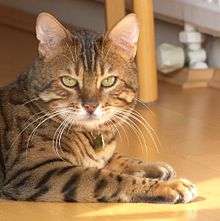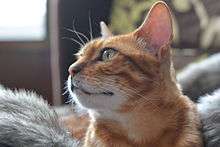Bengal cat
| Bengal Cat | |
|---|---|
 Bengal cat | |
| Origin | United States |
| Foundation bloodstock | Egyptian Mau, Abyssinian, and others (domestic); Asian leopard cat (wild) |
| Breed standards | |
| FIFe | standard |
| TICA | standard |
| AACE | standard |
| ACF | standard |
| ACFA/CAA | standard |
| GCCF | standard |
| Feline hybrid (Felis catus × Prionailurus bengalensis bengalensis) | |
.jpg)
The Bengal is a domestic cat breed developed to look like exotic jungle cats such as leopards, ocelots, margays and clouded leopards. Bengal cats were developed by the selective breeding of domestic cats crossed then backcrossed and backcrossed once more with hybrids from the Asian leopard cat (ALC), Prionailurus bengalensis bengalensis, and domestic cat, with the goal of creating a confident, healthy, and friendly cat with a highly contrasted and vividly marked coat.[1]
The name "Bengal cat" was derived from the taxonomic name of the Asian leopard cat (P. b. bengalensis). They have a "wild" appearance with large spots/rosettes/arrowheads, and a light/white belly, and a body structure reminiscent of the ALC.[2] Once separated by at least four generations from the original ALC × domestic cat crossing, the breed possesses a gentle domestic cat temperament.[2]
Bengal cats are generally a bright orange to light brown colour, although pale or off-white "snow" Bengals also exist, and are popular among owners.
History
Early history
The earliest mention of an Asian leopard cat × domestic cross was in 1889, when Harrison Weir wrote of them in Our Cats and All About Them.[3]
However, in 1927, C. Boden Kloss wrote to the magazine Cat Gossip[4] regarding hybrids between wild and domestic cats in Malaya: "I have never heard of hybrids between bengalensis (the Leopard Cat) and domestic cats. One of the wild tribes of the Malay Peninsula has domesticated cats, and I have seen the woman suckling bengalensis kittens, but I do not know whether the latter survive and breed with the others!"[5]
The earliest mention of a confirmed ALC × domestic cross was in 1934, in a Belgian scientific journal., and in 1941, a Japanese cat publication printed an article about one that was kept as a pet.[6] Jean Mill (née Sugden), the person who was later a great influence on the development of the modern Bengal breed, submitted a term paper for her genetics class at UC Davis on the subject of crossbreeding cats in 1946.[5]
Bengals as a breed
In the 1970s, William Centerwall bred ALCs with domestic cats to aid his studies in genetics because of their apparent immunity to feline leukemia. Eventually, these hybrids were given to Jean Sudgen Mill because of Centerwall's illness.
At the same time, Bill Engler wanted to preserve the exotic cats' genes by breeding them with house cats. Although none of today's Bengal lines originate from these cats, he chose the name "Bengal", which was accepted by the American Cat Fanciers Association (ACFA), the first registry to accept the breed.

Jean Mill was instrumental in recognition of Bengals as a breed by The International Cat Association (TICA) in 1983. Her plan was not to keep the breed as a hybrid, but to domesticate these cats by breeding them further with each other.[7]

Greg and Elizabeth Kent were also early breeders, who developed their own line of Bengals using ALCs and Egyptian Maus. This was a very successful line and many modern Bengals will find it in their pedigree.
Legal developments

The UK Department for Environment, Food and Rural Affairs, DEFRA, removed the previous licensing requirements for the keeping of Bengal cats in the United Kingdom in 2007.[8]
Appearance

Bengal cats have "wild-looking" markings, such as large spots, rosettes, and a light/white belly, and a body structure reminiscent of the leopard cat.[2] A Bengal's rosetted spots occur only on the back and sides, with stripes elsewhere. The breed typically also features "mascara" (horizontal striping alongside the eyes), and foreleg striping. The eyes of a Bengal cat are relatively large and are usually bright blue or green.
The Bengal cat is usually either classed as brown-spotted or snow-spotted (although there are more colours, brown and snow are the only colours of Bengal that the Governing Council of the Cat Fancy (UK) recognize). Within brown Bengals, there are either marble or spotted markings. Included in the spotted variation is rosetted, which consists of a spot with a dark line surrounding it. Snow Bengals are also either marble or spotted, but are also divided into blue-eyed or any other colour eyes.
The International Cat Association recognizes several Bengal colours (brown, seal lynx point, mink, sepia, silver) and patterns (spotted and marbled) for competition and shows. In the New Traits class, other colours may be shown, as well as longhairs.[9]
Alongside other hybrid cat breeds such as the Savannah, Bengal cats are typically larger than the average house cat. Males on average weigh between 10-15 lbs (4.5 – 6.8 kg) and females 8–12 lbs (3.6 – 5.4 kg).[10]
Temperament
After three generations from the original crossing, the breed usually acquires a gentle domestic cat temperament;[2] however, for the typical pet owner, a Bengal cat kept as a pet should be at least four generations (F4) removed from the leopard cat. The so-called foundation cats from the first three filial generations of breeding (F1–F3) are usually reserved for breeding purposes or the specialty pet home environment.[11] Bengals are known for liking water,[12] and require a large amount of attention to keep them happy. Bengals also enjoy playing, and have been recorded jumping over 4 feet from the ground.
Health
A novel autosomal recessive disorder was described in Bengals in 2011, decades after the breed's development. This disease appears to be an early-onset primary photoreceptor disorder, leading to blindness within the first year of age, in cats that possess the anomaly.[13]
The prevalence of hypertrophic cardiomyopathy (HCM) is 16.7% (95% CI = 13.2–46.5%).[14]
Blood type
Most Bengal cats have type A blood according to a study held in the UK. Using RapidVet-H Feline blood typing cards (dms Laboratories), 98 of 100 Bengal cats tested positive for blood type A. The other two Bengal cats were retested and were found to be type A as well. This led to the conclusion that Bengal cats are predominantly Type A.[15]
Shedding and grooming
As well as being desired for their appearance, they are also known for being a breed that sheds very little. Many claim that the Bengal is a hypoallergenic breed, but this is purely anecdotal evidence, and while some people may not react, others will still have an allergic reaction to them. This is to do with the dander of the cat and not the amount that it sheds.[16]
Bengals are extremely efficient self-groomers, therefore they require little grooming. However, vets do recommend grooming once a week to limit shedding and keep their coat healthy.[17]
Long-haired variant
Some long-haired Bengals (more properly semi-long-haired) have occurred since the beginning of the Bengal breeding program,[18] as longer-haired domestic cats were among those used in crosses with the wild Asian leopard cat to produce the breed. Some current F4 and later purebred Bengals carry the recessive long-haired genes and when they are mated with each other, they can produce long-haired Bengals. (See Cat coat genetics#Genes involved in fur length and texture.) Such offspring were usually spayed or neutered until ongoing intentional development of the long-hair variety, as they did not then qualify as Bengal breeding stock due to their non-conforming long or semi-long coats. On August 21, 2013, long-haired Bengals were granted "preliminary" breed status in the New Zealand Cat Fancy (NZCF) registry under the breed name Cashmere, at the behest of a breeder named Damian Vaughan.[19][20] They are currently not recognized by any other cat registries.
Cheetoh crossbreed
The Cheetoh cat is an ongoing program to crossbreed two existing breeds of spotted domestic cats with defined characteristics (the Bengal and the Ocicat), and develop the result into a third standardized breed that is distinct from both of the foundation breeds.[21] They were initially recognized by only a single minor and permissive breed registry, the United Feline Organization (UFO), starting in November 2004, but have been granted "experimental breed" status (not eligible for show competition) by a major registry, The International Cat Association (TICA), since at least May 2009, under the name Experimental Cheetoh, breed code XCT,[22] a status they still retain as of 2016.[23]
References
- ↑ "Archived copy". Archived from the original on April 14, 2015. Retrieved April 9, 2015.
- 1 2 3 4 Bengal Cat Animal World, Information Resource: Exotic Pets & Animals. Retrieved on: January 18, 2008
- ↑ Harrison William Weir, Our Cats and All About Them: Their Varieties, Habits, and Management, (Houghton, Mifflin & Co., 1889), p. 55.
- ↑ Cat Gossip, Periodical.
- 1 2 "A Brief History of the (Bengal) Universe". Bengal Classifieds. Retrieved 2009-10-25.
- ↑ Hartwell, Sarah. "Domestic x Asian Leopard Cat and Margay Hybrids". Messybeast. Retrieved November 13, 2015.
- ↑ "History of the Bengal Cat". Bengaland.com. Retrieved 2016-04-02.
- ↑ "The Dangerous Wild Animals Act 1976 (Modification) Order 2007". Legislation.gov.uk. 2014-11-04. Retrieved 2016-04-02.
- ↑ Alan Brown. "Bengal cats & kittens - The International Bengal Cat Society - TIBCS - exotic looks with spots, marbling and snow". Bengalcat.com. Retrieved 2013-09-12.
- ↑ "Bengal Cat Facts | Bengal Cat World". Bengalcatworld.com. Retrieved 2015-11-15.
- ↑ "Breeding the ALC with domestic cats". Bengalcat.co.uk. Retrieved 2013-09-12.
- ↑ "Distinct character of the bengal cat". Bengalcat.co.uk. Retrieved 2016-04-02.
- ↑ Narfström, K., Menotti-Raymond, M., Seeliger, M. (2011) Characterization of feline hereditary retinal dystrophies using clinical, functional, structural and molecular genetic studies. Veterinary Ophthalmology (2011) 14, Supplement 1: 30–36.
- ↑ "Myosin-Binding Protein C DNA Variants in Domestic Cats (A31P, A74T, R820W) and their Association with Hypertrophic Cardiomyopathy - Longeri - 2013 - Journal of Veterinary Internal Medicine - Wiley Online Library". Onlinelibrary.wiley.com. 2013-01-17. Retrieved 2013-11-02.
- ↑ Danièlle A. Gunn-Moore (2011-01-01). "Feline Blood Transfusions: A Pinker Shade of Pale - 2011 Journal of Feline Medicine and Surgery". Journal of Feline Medicine and Surgery. Retrieved 2016-04-25.
- ↑ "Bengal Cats–Are They Hypoallergenic? | Bengal Cats – Bengals Illustrated". www.bengalsillustrated.com. Retrieved 2015-11-15.
- ↑ "Bengal Cat Breed Information". Vetstreet. Retrieved 2015-11-15.
- ↑ Potter, Cathy (2006). ""Cashmere"—The Longhair Bengal". Grand Rapids, Michigan: AuroraLights Bengals. Archived from the original on 2013-09-27. Retrieved 2013-09-17.
We (Longhair breeders as a group) decided on the name 'Cashmere' due to the fact that the Longhairs have such an amazingly soft and silky coat. The Longhairs were not developed intentionally, but instead have occurred since the beginning of the Bengal breeding programs.
- ↑ "Minutes of Executive Council Meeting, August 2013". New Zealand Cat Fancy. Retrieved 22 December 2013.
- ↑ "Agenda for Executive Council Meeting, August 2013" (PDF). New Zealand Cat Fancy. Retrieved 22 December 2013.
- ↑ Domestication by Clive Roots, p. 114, Greenwood Publishing Group, 2007. Books.google.com. Retrieved 2013-09-12.
- ↑ "Standing Rules, 2009 Version A" (PDF). TICA.org. The International Cat Association. May 1, 2009. p. 53, §701.4.5. Archived from the original (PDF) on July 31, 2009. Retrieved August 16, 2016.
- ↑ "Standing Rules, 2016 Version A" (PDF). TICA.org. The International Cat Association. April 11, 2016. p. 54, §701.4.5. Archived (PDF) from the original on June 18, 2016. Retrieved August 16, 2016.
External links
| Wikimedia Commons has media related to: |
- The International Bengal Cat Society
- Complete Bengal Cat History
- Bengal Cat Guide
- Bengal Genetics
- Owning a Bengal Cat